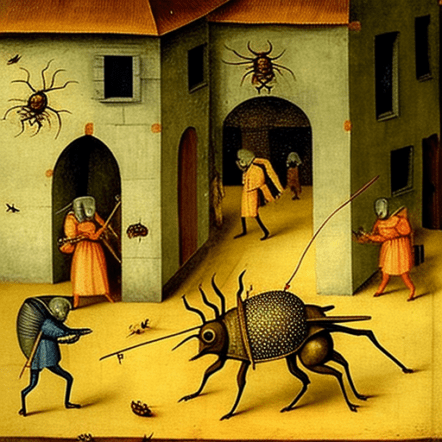Table of Contents
Fleas are pesky insects that can survive by feeding on mammal blood when they are adults. When they are young, they consume the dry blood that adult fleas excrete. If you don’t want fleas sharing your home with you, follow the advice listed below.
Environmental Eradication
When possible, fleas make their homes on the animals they use for food. The eggs they lay will mostly be found in the surrounding environment, such as the carpet, pet bedding, clothing, and lots of other areas. It takes a week or two for the eggs to hatch. Once this happens, the young flea larvae live in the same place for a long time until they finally mature into pupae. This can take up to 200 days. Once they become pupae, they can survive dormant for a year or more waiting for the right moment to become an adult and find a host. This is why your first step needs to be to thoroughly clean every possible place where eggs and larvae could be present.
Getting Started
- Find a place to quarantine all pets.
- Gather up everything your pet comes in contact with and thoroughly wash them with soap and hot water. If you can’t properly clean it, dispose of it. The eggs look like grains of salt, with pepper sprinkled around, which is the dried blood defecated by the adults.
- Thoroughly vacuum everywhere possible, including furniture and anywhere else your pet spends time. Eggs are fairly easy to vacuum up, but the larvae will cling to the fibers, and you probably won’t remove them by vacuuming. Once you finish, take the bag out of the machine and either dispose of it outside or seal it in a plastic bag and place it in the freezer for several hours. Afterward, you can reuse the bag.
- To get rid of the stubborn larvae clinging to the carpet fibers, you’ll need the services of a professional cleaner with steam cleaning equipment. If you choose not to go this route, you can also thoroughly clean the carpet using a shampoo that contains an anti-flea insecticide. One final solution is infrared heat treatment that professional exterminators can perform.
- Don’t forget to treat the pet’s outdoor areas by flushing the area with lots of soap and water.
Removing Fleas from People and Pets

When you have the indoor flea problem taken care of, it’s time to move to the host and attack the adult fleas directly.
Removal from Humans
- Humans should bathe at least daily, and twice daily is better. Wash the hair thoroughly.
- Comb hair, especially long hair, using a specially designed flea comb that grabs the fleas as it passes through the hair. Dip it in soapy water to remove the fleas. Keep track of any fleas you remove so you can track the infestation and determine if the population is continuing to increase.
Removal from Pets
You must take care when treating your pets for fleas. Make sure that the treatment product you are using is designed for the type of pet you are using it on. If you use a dog flea treatment on a cat, illness or even death can occur. Make sure you read the directions thoroughly and follow any precautions listed.
- The first step is to bathe your pet in warm, soapy water. You can use special shampoos that contain anti-flea insecticide, but normal shampoo will also work. Do not use insecticidal shampoos that contain DEET, which can cause allergic reactions. One non-toxic flea shampoo that contains insecticide is Safer’s flea shampoo.
- Use the special flea comb on your pet at least once daily. Dip the comb in soapy water to remove the fleas from the comb and dispose of them. This also allows you to keep track of the flea population. Some people choose to wrap tape around their hands with the sticky side out and pat down their animal. This works well for short-haired animals but isn’t very effective on pets with long hair.
Flea Bite Allergies
In some people, flea bites cause an allergic reaction that leads to dermatitis. Lesions can also form, and the bites are extremely itchy. A variety of products that will relieve the symptoms are available, such as calamine, camphor, and menthol. Ice also works well. To prevent the fleas from biting you in the first place, you can use one of the available insect repellents that contain DEET. This should be applied to your clothing only. Do not apply it to your skin or to your pets. Some B vitamins are also effective flea repellents. A daily B-complex vitamin is an effective deterrent. Doctors can prescribe allergen treatments to those people with severe reactions to flea bites. These are effective in treating the flea bite allergy. If you notice hair loss in your pet, you might suspect that they too have a flea allergy. The most common areas are around the base of the tail and the feet. You’ll probably notice the pet chewing the area often. Animals with bad health or a poor diet are more susceptible to flea allergies, so make sure they are in good health and eating well.
Continuous Flea Control Measures

Once you take care of the initial flea infestation, you need to take measures to ensure the infestation doesn’t return and to get rid of any remaining fleas that could cause the problem to return. If you allow them to reproduce, the infestation will return quickly. This section consists of a guide to help you keep the flea problem from returning.
Flea Prevention Procedures
- Keep your pets confined to areas of the house that are easy to clean and to treat. Areas with lots of hiding places like basements and garages should be avoided.
- Frequent vacuuming is essential. The best plan is to vacuum every day. This will help get rid of any fleas that hatch from the eggs that were missed. Don’t forget to remove the vacuum bag and either put it in the freezer or dispose of it.
- Make sure your pet’s bedding is of a type that can be easily washed. If your pet likes to lay on a carpeted area, put down a towel that you can change out and wash often.
- Wash your pets as frequently as possible and comb them with the flea comb every day. Track the number of fleas you find to ensure the population is not surging, which means you might need to perform another in-depth cleaning.
In Extreme Situations
If, for some reason, the steps you’ve taken to rid yourself of your flea problem haven’t been successful, you may need to take more extreme measures and perform additional tasks.
- You can purchase and apply a substance called an insect growth regulator to your environment. This is a liquid that contains either methoprene or fenoxycard that will inhibit the growth cycle of the fleas and can be effective for up to 200 days per treatment.
- Continue to wash outdoor areas using soap and water to flush away the fleas.
- Use flea control measures such as flea powders, sprays, and flea collars. The collars remain very potent and can cause health problems if used for too long. As soon as you determine that the fleas are gone, remove the collar. When using the collar, check your pet often for problems such as irritation underneath the collar.
- Frequently clean your carpets with insecticidal shampoo or a steam cleaner.
As a last option, it’s time to call the professional exterminators and let them use more sophisticated equipment.
Products to Control Fleas

Although there are several chemical products available that can help control fleas, you should only use them as a last resort when soap and water will not work. These can cause health problems in many animals, especially when used long term. There are also some natural products that are much safer.
Growth Inhibitors
Insect growth inhibitors interrupt the natural life cycle of young fleas. These treatments are very effective and can control flea problems for up to 200 days. The larvae, eggs, and pupae are prevented from continuing to mature into adult fleas. Make sure that you are using other methods such as vacuuming, bathing pets, and washing bedding to make sure the inhibitors are as effective as possible.
Citrus-Based Products
Flea control products made from the extract of citrus fruit peels are safe. They are most effective if several different types of citrus products are used in conjunction since certain products interfere with different cycles of flea development. The products are most effective when used to clean and treat bedding. If you plan to use the products on your pets, make sure the EPA has rated them safe for such use. If you are in doubt, check with your vet.
Dusts
Another method is a substance called a sorptive dust. One type of sorptive product is made out of diatomaceous earth. These products dehydrate the fleas, causing them to die. These products are safe to use on both carpets and directly on your pets. When applying it to carpet, keep pets away and wear a dust mask to protect your lungs. When applying to pets, long-haired pets will need a second application. Once you dust the pets, keep them in a confined area for a while to give the fleas time to encounter the product. Active pets can cause the dust to fall off. Once you treat the animal, do not allow them to get wet or bathe them for several days. Consult with your vet before using this type of product on a cat.
Pyrethrins
A very safe and non-toxic flea product is made of pyrethrin and comes from the chrysanthemum flower. As long as the pyrethrin concentration is less than .04%, it is safe for pets. Be aware that pyrethrin comes with a more toxic product called piperonyl butoxide, which is toxic to both humans and animals.
Flea Collars
Flea collars are simply a vessel for insecticides that are emitted in vapor form. For short-term use, they are fairly safe, but prolonged exposure can cause health problems in animals and humans both. When using flea collars, check your pet’s skin for signs of irritation and only use the collar as long as you have a flea problem. When not in use, the collars should be sealed in a plastic bag.
Electronic Devices
You will often see ultrasonic devices for sale, but these have been proven to be ineffective. It’s better to use proven methods of flea eradication and control than to waste money on a product that won’t solve your problem.

